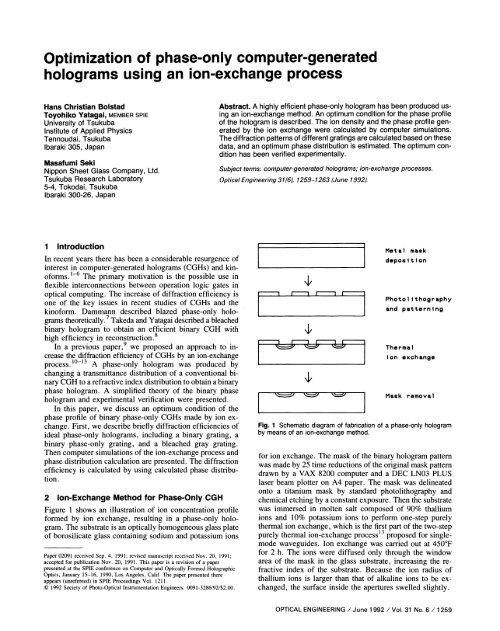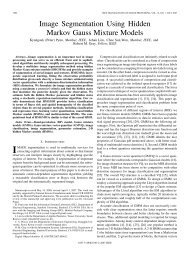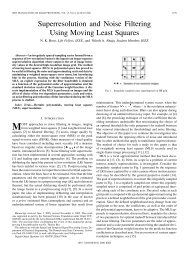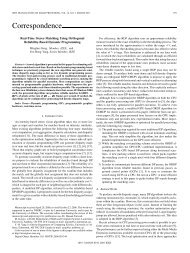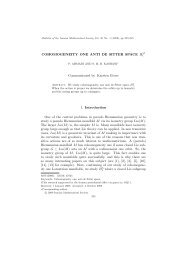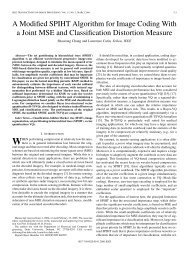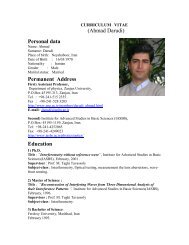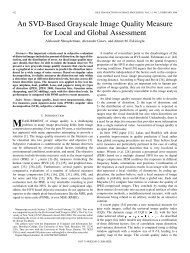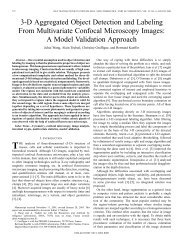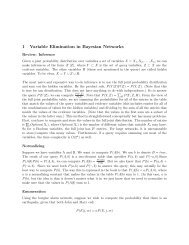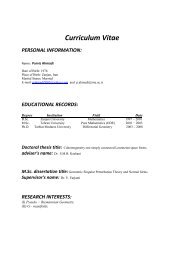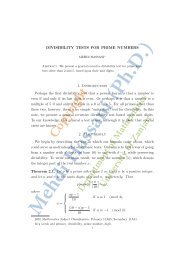Optimization of phase-only computer-generated holograms using
Optimization of phase-only computer-generated holograms using
Optimization of phase-only computer-generated holograms using
You also want an ePaper? Increase the reach of your titles
YUMPU automatically turns print PDFs into web optimized ePapers that Google loves.
<strong>Optimization</strong> <strong>of</strong> <strong>phase</strong>-<strong>only</strong> <strong>computer</strong>-<strong>generated</strong><br />
<strong>holograms</strong> <strong>using</strong> an ion-exchange process<br />
Hans Christian Boistad<br />
Toyohiko Yatagai, MEMBER SPIE<br />
University <strong>of</strong> Tsukuba<br />
Institute <strong>of</strong> Applied Physics<br />
Tennoudai, Tsukuba<br />
lbaraki 305, Japan<br />
Masafumi Seki<br />
Nippon Sheet Glass Company, Ltd.<br />
Tsukuba Research Laboratory<br />
5-4, Tokodai, Tsukuba<br />
lbaraki 300-26, Japan<br />
1 Introduction<br />
In recent years there has been a considerable resurgence <strong>of</strong><br />
interest in <strong>computer</strong>-<strong>generated</strong> <strong>holograms</strong> (CGHs) and kin<strong>of</strong>orms.<br />
1-6 The primary motivation is the possible use in<br />
flexible interconnections between operation logic gates in<br />
optical computing. The increase <strong>of</strong> diffraction efficiency is<br />
one <strong>of</strong> the key issues in recent studies <strong>of</strong> CGHs and the<br />
kin<strong>of</strong>orm. Dammann described blazed <strong>phase</strong>-<strong>only</strong> <strong>holograms</strong><br />
theoretically.7 Takeda and Yatagai described a bleached<br />
binary hologram to obtain an efficient binary CGH with<br />
high efficiency in reconstruction.8<br />
In a previous paper,9 we proposed an approach to increase<br />
the diffraction efficiency <strong>of</strong> CGHs by an ion-exchange<br />
1013 A <strong>phase</strong>-<strong>only</strong> hologram was produced by<br />
changing a transmittance distribution <strong>of</strong> a conventional binary<br />
CGH to a refractive index distribution to obtain a binary<br />
<strong>phase</strong> hologram. A simplified theory <strong>of</strong> the binary <strong>phase</strong><br />
hologram and experimental verification were presented.<br />
In this paper, we discuss an optimum condition <strong>of</strong> the<br />
<strong>phase</strong> pr<strong>of</strong>ile <strong>of</strong> binary <strong>phase</strong>-<strong>only</strong> CGHs made by ion exchange.<br />
First, we describe briefly diffraction efficiencies <strong>of</strong><br />
ideal <strong>phase</strong>-<strong>only</strong> <strong>holograms</strong>, including a binary grating, a<br />
binary <strong>phase</strong>-<strong>only</strong> grating, and a bleached gray grating.<br />
Then <strong>computer</strong> simulations <strong>of</strong> the ion-exchange process and<br />
<strong>phase</strong> distribution calculation are presented. The diffraction<br />
efficiency is calculated by <strong>using</strong> calculated <strong>phase</strong> distribution.<br />
2 Ion-Exchange Method for Phase-Only CGH<br />
Figure 1 shows an illustration <strong>of</strong> ion concentration pr<strong>of</strong>ile<br />
formed by ion exchange, resulting in a <strong>phase</strong>-<strong>only</strong> hologram.<br />
The substrate is an optically homogeneous glass plate<br />
<strong>of</strong> borosilicate glass containing sodium and potassium ions<br />
Paper 02091 received Sep. 4, 1991; revised manuscript received Nov. 20, 1991;<br />
accepted for publication Nov. 20, 1991. This paper is a revision <strong>of</strong> a paper<br />
presented at the SPIE conference on Computer and Optically Formed Holographic<br />
Optics, January 15—16, 1990, Los Angeles, Calif. The paper presented there<br />
appears (unrefereed) in SPIE Proceedings Vol. 1211.<br />
1992 Society <strong>of</strong> Photo-Optical Instrumentation Engineers. 0091-3286/92/$2.00.<br />
Abstract. A highly efficient <strong>phase</strong>-<strong>only</strong> hologram has been produced <strong>using</strong><br />
an ion-exchange method. An optimum condition for the <strong>phase</strong> pr<strong>of</strong>ile<br />
<strong>of</strong> the hologram is described. The ion density and the <strong>phase</strong> pr<strong>of</strong>ile <strong>generated</strong><br />
by the ion exchange were calculated by <strong>computer</strong> simulations.<br />
The diffraction patterns <strong>of</strong> different gratings are calculated based on these<br />
data, and an optimum <strong>phase</strong> distribution is estimated. The optimum condition<br />
has been verified experimentally.<br />
Subject terms: <strong>computer</strong>-<strong>generated</strong> <strong>holograms</strong>; ion-exchange processes.<br />
Optical Engineering 3 1(6), 1259-1263 (June 1992).<br />
___ [1 ri I 1<br />
___<br />
4' ___ ___<br />
1<br />
4, ___ ___<br />
4,<br />
Metal mask<br />
depos I t Ion<br />
Photo 1 ithography<br />
and patterning<br />
Thermal<br />
Ion exchange<br />
Mask removal<br />
Fig. 1 Schematic diagram <strong>of</strong> fabrication <strong>of</strong> a <strong>phase</strong>-<strong>only</strong> hologram<br />
by means <strong>of</strong> an ion-exchange method.<br />
for ion exchange. The mask <strong>of</strong> the binary hologram pattern<br />
was made by 25 time reductions <strong>of</strong> the original mask pattern<br />
drawn by a VAX 8200 <strong>computer</strong> and a DEC LNO3 PLUS<br />
laser beam plotter on A4 paper. The mask was delineated<br />
onto a titanium mask by standard photolithography and<br />
chemical etching by a constant exposure. Then the substrate<br />
was immersed in molten salt composed <strong>of</strong> 90% thallium<br />
ions and 10% potassium ions to perform one-step purely<br />
thermal ion exchange, which is the first part <strong>of</strong> the two-step<br />
purely thermal ion-exchange process13 proposed for singlemode<br />
waveguides . Ion exchange was carried out at 450°F<br />
for 2 h. The ions were diffused <strong>only</strong> through the window<br />
area <strong>of</strong> the mask in the glass substrate, increasing the refractive<br />
index <strong>of</strong> the substrate. Because the ion radius <strong>of</strong><br />
thallium ions is larger than that <strong>of</strong> alkaline ions to be exchanged,<br />
the surface inside the apertures swelled slightly.<br />
OPTICAL ENGINEERING / June 1 992 / Vol. 31 No. 6 / 1259
1.0 -<br />
0.5<br />
0<br />
0<br />
Amp ii tude<br />
(a) (b)<br />
Fig. 2 Transmittance functions <strong>of</strong> a binary amplitude<br />
gray grating (c).<br />
1260 / OPTICAL ENGINEERING / June 1992 / Vol. 31 No. 6<br />
x<br />
BOLSTAD, YATAGAI, and SEKI<br />
0.5<br />
Phase Phase<br />
3 Diffraction Efficiency <strong>of</strong> Ideal Phase-Only<br />
Holograms<br />
The diffraction efficiencies <strong>of</strong> gray and binary gratings were<br />
14<br />
originally described by Brown and<br />
First we<br />
will describe these and then the diffraction efficiencies <strong>of</strong><br />
their <strong>phase</strong>-<strong>only</strong> counterparts. For simplicity, consider the<br />
diffraction efficiency difference between a binary grating<br />
and its <strong>phase</strong> version, as shown in Fig. 2. The transmittance<br />
function <strong>of</strong> a binary grating with a period <strong>of</strong> L\v is given<br />
0<br />
Amp] itude Amp] itude<br />
grating (a), its <strong>phase</strong> version (b), and a bleached<br />
0<br />
4.)<br />
>.,<br />
u<br />
C<br />
a)<br />
a<br />
4-<br />
4w<br />
1.e<br />
0.5<br />
0<br />
x x<br />
Phase<br />
x x x<br />
by 0<br />
211'<br />
Phase Difference<br />
_1 m1 . Tb (2irnx<br />
2 7T'fl Lv ) ' (1) Fig. 3 Theoretical plot <strong>of</strong> diffraction efficiency ratio R and R' versus<br />
<strong>phase</strong> difference 0.<br />
where m denotes the modulation level <strong>of</strong> the grating and<br />
O
OPTIMIZATION OF PHASE-ONLY COMPUTER-GENERATED HOLOGRAMS<br />
Fig. 4 Flow diagram <strong>of</strong> <strong>computer</strong> simulation for <strong>phase</strong> pr<strong>of</strong>ile estimation.<br />
This is also plotted in Fig. 3 for the case m =1 . The maximum<br />
diffraction efficiency is not obtained at 0 =ir, but<br />
0=3.6 rad or 220 deg.<br />
4 Phase Pr<strong>of</strong>ile Simulation<br />
It is possible to simulate some <strong>of</strong> the processes described<br />
so far, diffusion, <strong>phase</strong>-shift, and reconstruction, by <strong>using</strong><br />
a digital <strong>computer</strong>. The flow diagram <strong>of</strong> the simulation is<br />
shown in Fig. 4. First we consider the calculation <strong>of</strong> the<br />
ion-diffusion pr<strong>of</strong>ile (ion-concentration pr<strong>of</strong>ile). The resulting<br />
ion-concentration after ion exchange can be calcu-<br />
lated by solving the 2-D diffusion equation numerically<br />
12<br />
<strong>using</strong> the finite difference An actual pr<strong>of</strong>ile can<br />
be calculated/simulated from the given data for the experiment.<br />
This was done <strong>using</strong> a VAX 8200 <strong>computer</strong>. In order<br />
to simplify programming, we assumed the diffusion constant<br />
to be concentration independent. This is a rough approximation,<br />
if the ion concentration is very high. Necessary<br />
inputs are time <strong>of</strong> diffusion, aperture size, and diffusion<br />
constant. A relation between ion concentration in a diffused<br />
area and the change in refractive index has been found<br />
empirically, and can be expressed as follows:<br />
n=aC+b,<br />
where n is the index change in the local area, C is the local<br />
concentration <strong>of</strong> ions <strong>of</strong> thallium exchanged with sodium,<br />
and a and b are constants.<br />
Using an experimental relation,9 the final index increase<br />
in a local area can be found <strong>using</strong> a linear relation. The<br />
concentration <strong>of</strong> ions (thallium) exchanged with sodium!<br />
potassium ions is 90% near the surface <strong>of</strong> the aperture opening,<br />
and gradually decreasing to 0% in substrate material.<br />
To find the actual index change over the full depth <strong>of</strong><br />
the diffusion area, we calculate as follows. Consider the<br />
coordinate in the depth direction as x. A small element along<br />
(9)<br />
V<br />
4.)<br />
a)<br />
0<br />
E<br />
'1e<br />
C<br />
o8<br />
4.,<br />
.; 6<br />
0<br />
0_4<br />
2<br />
0<br />
—2<br />
—4<br />
—6<br />
—6<br />
—10 0 2 4 6 0 10<br />
Diffusion Depth (urn)<br />
Fig. 5 Simulation result <strong>of</strong> index change.<br />
this direction is called zx. The ion concentration <strong>of</strong> thallium<br />
is found in each small element according to Eq. (9). This<br />
is actually done in 20 elements. We can now find the total<br />
<strong>phase</strong> change by the following equation:<br />
(pi= , (10)<br />
where and L1x1 denote the local change <strong>of</strong> the refractive<br />
index in the position <strong>of</strong> the (i,j)'th element and a small<br />
distance element, respectively. The result <strong>of</strong> inserting the<br />
experimental data for 120 mm <strong>of</strong> diffusion time and a mole<br />
percentage <strong>of</strong> 90% thallium is shown in Fig. 5. For this<br />
case, the maximum index change along the depth direction<br />
is n =0.01, and this corresponds to a total <strong>phase</strong> change <strong>of</strong><br />
240 deg when <strong>using</strong> 633-nm laser light. The diffusion length<br />
<strong>of</strong> thallium is measured to be 6 xm.<br />
5 Phase-Only Grating and Their Diffraction<br />
Efficiency<br />
There has been no earlier report on <strong>holograms</strong> made by this<br />
technique, and making such an element was also considered<br />
as a test <strong>of</strong> the limitations <strong>of</strong> ion-diffusion-made elements.<br />
In our experiment, the smallest aperture was about 3 rim.<br />
Because <strong>of</strong> sideways diffusion, a good result was achieved<br />
mainly for apertures larger than 5 jim and more than 20 pm<br />
apart. With a smaller spacing between the apertures, they<br />
tended to ''fuse' ' together.<br />
By knowing the index increase in a local area, we can<br />
find the <strong>phase</strong> pr<strong>of</strong>ile <strong>of</strong> a plane wave passing through the<br />
aperture in a vertical direction. The optical path length is<br />
an integral over the index distribution multiplied by the<br />
length. Then, multiplying the difference in optical path length<br />
with the wave number k gives the <strong>phase</strong> pr<strong>of</strong>ile after a single<br />
pass. We have here neglected refraction due to the small<br />
depth (5 to 10 iim) <strong>of</strong> an aperture. The integral mentioned<br />
above can be found by summing the local index values<br />
multiplied a small distance x. Doing this for all columns<br />
gives the final pr<strong>of</strong>ile.<br />
OPTICAL ENGINEERING / June 1992 / Vol. 31 No. 6 / 1261
0<br />
4-<br />
-C<br />
U)<br />
6)<br />
0<br />
-C<br />
0<br />
63<br />
><br />
6)<br />
Position x<br />
Fig. 6 Phase pr<strong>of</strong>ile <strong>of</strong> the wavefront through an aperture.<br />
Figure 6 shows an example <strong>of</strong> a <strong>phase</strong> pr<strong>of</strong>ile. A high<br />
index difference (aperture center area) gives a large <strong>phase</strong><br />
shift. Because <strong>of</strong> the diffusion that takes place in all directions,<br />
there is also a <strong>phase</strong> shift outside the aperture region.<br />
This causes <strong>only</strong> small reductions in diffraction efficiency,<br />
but is a major problem when making aperture <strong>holograms</strong>.<br />
Fourier transforming the <strong>phase</strong> pr<strong>of</strong>ile <strong>of</strong> Fig. 6 gives the<br />
diffraction pattern, and therefore also the diffraction effi-<br />
0.40<br />
0.35<br />
> 0.30<br />
6)<br />
0.25<br />
4-<br />
4- 0.20<br />
Li<br />
0.15<br />
L<br />
4-<br />
4- 0.10<br />
6)<br />
0.05<br />
0.00<br />
0.40<br />
0.35<br />
8.30<br />
0.25<br />
4-<br />
4. 0.20<br />
Li<br />
0.15<br />
0 8 16 24 32 40 48 56 64 72 80 88 96 104112120128136<br />
Pos I t I on<br />
1262 / OPTICAL ENGINEERING / June 1992 / Vol. 31 No. 6<br />
(a)<br />
C4<br />
4- 0.10<br />
8.05<br />
I I I I I Ji L I I I I<br />
a a 18 24 32 40 48 56 84 72 80 88 96 104112120128136<br />
Pos I t I on<br />
(c)<br />
BOLSTAD, YATAGAI, and SEKI<br />
Fig. 7 Calculated diffraction patterns: (a) 0=182.1<br />
(d) 0=240.3 deg.<br />
ciency, as shown in Fig. 7. In this figure we can see the<br />
result for four different <strong>phase</strong> pr<strong>of</strong>iles. It is drawn with the<br />
maximum <strong>phase</strong> shift as a variable. We can see that at near<br />
180 deg, there is still a considerable energy left in the zeroorder<br />
(30%), whereas there is about 35% in the first orders.<br />
Increasing the <strong>phase</strong> shift to about 220 deg gave the best<br />
result for this particular pr<strong>of</strong>ile with 13% left in the zero<br />
order and about 37% in the first orders, compared to the<br />
theoretical limit <strong>of</strong> 40% for a binary <strong>phase</strong>-<strong>only</strong> grating.<br />
Other pr<strong>of</strong>iles had even higher efficiencies. Figure 8 shows<br />
the best result with maximum <strong>of</strong> 38.5% in the first orders<br />
at 210-deg <strong>phase</strong> shift, which is very close to theoretical<br />
prediction <strong>of</strong> 0 — 220 deg. A corresponding low diffraction<br />
efficiency <strong>of</strong> 5% is obtained at 250 deg for the zero order.<br />
Because <strong>of</strong> the broadening <strong>of</strong> the <strong>phase</strong> pr<strong>of</strong>ile in the ion<br />
exchange there is a shift in the efficiency curve to a somewhat<br />
higher <strong>phase</strong> shift compared to the theoretical result<br />
for a rectangular grating.<br />
6 Conclusion<br />
We have proposed the use <strong>of</strong> an ion-exchange technique to<br />
produce binary <strong>phase</strong>-<strong>only</strong> CGHs. The optimum ion-exchange<br />
condition is discussed. For binary <strong>phase</strong>-<strong>only</strong> <strong>holograms</strong>,<br />
the optimum amount <strong>of</strong> <strong>phase</strong> change is IT, whereas this<br />
condition is shifted to 220 deg in the ion-exchange case<br />
0.40<br />
0.35<br />
> 0.30 -<br />
a)<br />
cj 0.25 -<br />
4-<br />
0.20<br />
LI<br />
0.15 -<br />
L<br />
IJI<br />
4-<br />
0.10<br />
0.05 -<br />
0.00 — I I I I I I I I I<br />
0 8 16 24 32 40 48 56 64 72 80 88 96 104112120128136<br />
>,.<br />
U<br />
C<br />
SI<br />
U<br />
4.<br />
1.<br />
Li<br />
4-<br />
4.<br />
0.35<br />
0.30<br />
Pos I t I on<br />
(b)<br />
I I IiI<br />
0 8 18 24 32 40 48 58 84 72 80 88 88 104112120128138<br />
Pos I t ion<br />
(d)<br />
deg, (b) 0 = 204.5 deg, (c) 0 = 226.9 deg, and
C)<br />
C<br />
a)<br />
ci<br />
Li<br />
C<br />
0<br />
4-)<br />
C)<br />
a)<br />
L<br />
'4-<br />
'4-<br />
50<br />
40<br />
30<br />
20<br />
10<br />
0<br />
-<br />
0 0.51T TI 1.511<br />
Phase Shift (rad)<br />
OPTIMIZATION OF PHASE-ONLY COMPUTER-GENERATED HOLOGRAMS<br />
2ff<br />
Fig. 8 Plot <strong>of</strong> calculated diffraction efficiency versus <strong>phase</strong> shift.<br />
when ion diffusion is considered. The technique presented<br />
here is expected to provide an efficient CGH that can be<br />
used in optical interconnection, three-dimensional image<br />
display, and other devices.<br />
Acknowledgment<br />
The authors are grateful to Hideki Hashizume and Shigeru<br />
Kobayashi <strong>of</strong> Nippon Sheet Glass Co. for their experimental<br />
assistance.<br />
References<br />
"<br />
— First order<br />
———— Zero order<br />
1 . W H. Lee, ''Computer-<strong>generated</strong> <strong>holograms</strong>: Techniques and applications,"<br />
Prog. Opt. 16, 121 (1987).<br />
2. W. J Dallas, The Computer in OpticalResearch, B. R. Frieden, Ed.,<br />
p. 291, Springer-Verlag, Berlin (1980).<br />
3. A. W. Lohmann and D. P. Paris, "Binary Fraunh<strong>of</strong>er <strong>holograms</strong> <strong>generated</strong><br />
by <strong>computer</strong>," Appi. Opt. 6, 1739 (1967).<br />
4. W. H. Lee, ' 'Sampled Fourier transform hologram <strong>generated</strong> by <strong>computer</strong>,"<br />
Appi. Opt. 9, 639 (1970).<br />
5. W. H. Lee, "Binary <strong>computer</strong>-<strong>generated</strong> <strong>holograms</strong>," Appi. Opt. 18,<br />
3661 (1979).<br />
6. L. B. Leesem, P. M. Hirsch, and J. Jordan, Jr. , ' 'The kin<strong>of</strong>orm: A<br />
new wavefront reconstruction device,' ' IBM J. Res. Dev. 13, 150<br />
(1969).<br />
7. H. Dammann, "Blazed Synthetic Phase-Only Holograms," Optik 31,<br />
95 (1970).<br />
8. M. Takeda and T. Yatagai, "Computer-<strong>generated</strong> hologram and kin<strong>of</strong>orm,"<br />
Oyobutsuri 41, 1039 (1972) (in Japanese).<br />
9. T. Yatagai, R. Sugawara, H. Hashizume, and M. Seki, "Phase-<strong>only</strong><br />
<strong>computer</strong>-<strong>generated</strong> hologram produced by an ion-exchange technique,"<br />
Opt. Lett. 13, 952 (1988).<br />
10. T. Yamagishi, K. Fujii, and I. Kitano, "Gradient-index rod lens with<br />
high NA. ," App!. Opt. 22, 400 (1983).<br />
11. M. Oikawa and K. Iga, "Distributed-index planar microlens," App!.<br />
Opt. 21, 1052 (1982).<br />
12. E. Okuda, I. Tanaka, and T. Yamagishi, "Planar gradient-index glass<br />
waveguide and its applications to a 4-port branched circuit and star<br />
couplar," App!. Opt. 23, 1745 (1984).<br />
13. M. Seki, H. Hashizume, and R. Sugawara, "Two-step purely thermal<br />
ion-exchange technique for single-mode waveguide devices in glass,"<br />
E!ectron. Lett. 24, 1258 (1988).<br />
14. B. R. Brown and A. W. Lohmann, ''Computer-<strong>generated</strong> binary <strong>holograms</strong>,'<br />
' IBM J. Res. Dev. 13, 160 (1969).<br />
Hans Christian Boistad received the MS<br />
degree in physics from the Norwegian Institute<br />
<strong>of</strong> Technology (NTH), Trondheim, in<br />
1987. Following this he was a research fellow<br />
for two years, working at the University<br />
<strong>of</strong> Tsukuba and later with Nippon Sheet<br />
Glass, Inc. , where he was engaged in modeling<br />
and fabrication <strong>of</strong> <strong>computer</strong> <strong>generated</strong><br />
<strong>holograms</strong>. He is currently working toward<br />
a PhD degree in fiber optics and MBE-<br />
____________ — grown GaAs/AIGaAs optical waveguide<br />
technology at . . I. He is a student member <strong>of</strong> IEEE.<br />
Toyohiko Yatagai received his DE degree<br />
in applied physics from the University <strong>of</strong><br />
Tokyo in 1 980. He joined Institute <strong>of</strong> Physical<br />
and Chemical Research in 1 970. Since<br />
1983, he has been an associate pr<strong>of</strong>essor<br />
in the Institute <strong>of</strong> Applied Physics, University<br />
<strong>of</strong>Tsukuba. He received an Optical Research<br />
Award from the Japan Society <strong>of</strong><br />
Applied Physics in 1978. He is active in<br />
optical computing and optical measurement<br />
research.<br />
Masafumi Seki received BS and MS degrees<br />
from the University <strong>of</strong> Tokyo in 1972<br />
and 1 974, respectively. From 1 974 to 1983,<br />
he was with the Central Research Laboratories<br />
<strong>of</strong> NEC Corporation and worked in<br />
the fields <strong>of</strong> optical fibers, microoptic devices,<br />
laser diodes, and related integrated<br />
optics. He pioneered WDM multiplexers,<br />
optical isolators for fiber optic communication<br />
and LD-isolator-SMF modules. In<br />
1985 he joined Tsukuba Research Laboratory<br />
<strong>of</strong> r! ,. I Glass Co., Ltd., where he has been working<br />
on guided-wave devices in glass and in LiNbO3. He is a member<br />
<strong>of</strong> OSA.<br />
OPTICAL ENGINEERING / June 1 992 / Vol. 31 No. 6 / 1263


